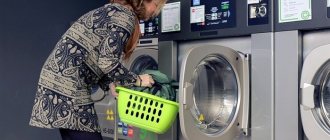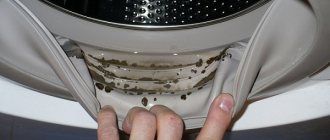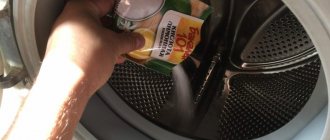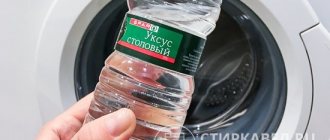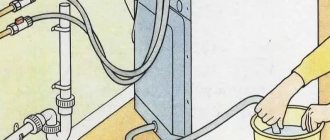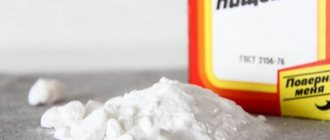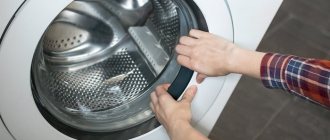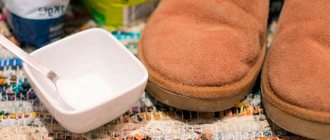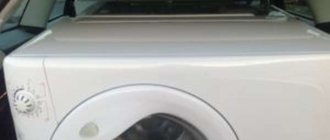Cleaning the body, door and sealing rubber
The rubber seal or cuff of the washing machine is a mandatory element of cleaning during the maintenance process. Rubber should be cleaned carefully, but efficiently, so that there are no leakage problems. Dirt and mold accumulate in this place - which is why it is important to clean regularly. Sediments in this area contribute to the appearance of unpleasant odors.
Any cleaning agent will help in the process, including regular baking soda. In some cases, if mold and a strong smell have already appeared, then it is worth using household chemicals:
- "Domestos".
- "Comet".
- “Whiteness” - it cannot be used often, as this leads to the destruction of the rubber seal. As a result, it will need to be changed.
The order for different means does not differ; it looks like this:
- Apply the product to the sponge.
- Carefully unscrew the cuff of the washing machine towards you.
- Wipe the metal elements of the housing.
- Clean the rubber itself. And not only in the lower part, where dirt accumulates the most, but throughout the entire diameter.
Important! Do not rub very hard so as not to damage the elastic band and other elements of the machine.
You also need to clean the car door. This can be done using a vinegar solution; you will need a 50% concentration of vinegar essence. It’s not difficult to prepare – just take equal parts of essence and water and mix well. All that remains is to wipe the glass and wipe it dry with a dry cloth. Gloves should be used when working with the solution.
The external elements of the washing machine should be wiped with a damp sponge; if necessary, you can use the existing cleaning agent.
Ways to clean the outer casing
If rust appears on the body of the washing machine, but the body is not rusted through, then it will need to not only be cleaned, but also painted. Cleaning and painting is carried out as follows:
- The surface with peeling paint and traces of corrosion must be cleaned using sandpaper (80 grit is suitable) or a grinder.
- Remove rust residues using a special “Tsiankovka” solvent. It is sold in spray form. The spray is applied to the cleaned surface and rubbed with a hard synthetic brush (an old toothbrush or one for cleaning clothes will do). Then wipe dry with a napkin.
- Cover the drum, door and areas of the body that are not damaged by corrosion with cellophane or cloth to prevent paint from getting on them.
- Warm up the surface with a hairdryer. Primer and paint adhere better to a heated surface and last longer.
- Apply primer in two layers. Between the first and second, pause for 10-15 minutes so that the first layer has time to dry. For work it is better to use primer and paint in cans. They are easy to apply and dry quickly.
- After the primer has dried, apply paint. The paint should be enamel for metal surfaces and the same color as the body of the washing machine. After a day, the machine can already be connected.
A housing with rusted holes will either have to be completely replaced or the holes will have to be welded.
If the machine has been brought to this state, then you can help solve the problem by contacting a specialist or replacing the metal body completely. It is not uncommon to see traces of rust on the plastic parts of the washing machine. The appearance of brown spots and smudges can be either a sign of corrosion of the metal body or a consequence of poor quality water. You can clean your car from rust from plastic and return it to its original appearance using Domestos, Comet or Mister Muscle. Any product for cleaning the surface from scale and rust is suitable. Apply and rinse with a sponge after 5-10 minutes.
Cleaning the powder tray
Before cleaning this component of the washing machine, it must be removed. If you don’t remember how to do this, it’s better to look in the instructions for the device so as not to break anything in the process. If you can’t remove the tray (this happens), you can still clean it, but you will need to pre-soak it. There are many places in the tray that are difficult to reach. To soak, you need to make a solution of any detergent and spray the tray with a spray bottle, leave for 2-3 hours. After this, cleaning will be much easier.
If you managed to remove the tray, then everything is even easier. If residues of powder or other product are found inside, it should be removed. This element needs cleaning, as over time a coating of rust, powder and other products forms on it. The following will help in removing all this plaque:
- Soda-vinegar mixture - proportions 1:2.
- Hot water + baking soda + vinegar - you need 3 parts water, 1 part baking soda and 2 parts vinegar.
Having prepared the product, it should be applied to all elements of the tray and left for 2-3 hours. Only then start cleaning with a sponge (large elements) and a toothbrush (hard-to-reach places). All that remains is to rinse the tray under running water and let it dry or wipe it dry.
Advice! If you have a dishwasher, you can wash the tray in it. It will not help get rid of plaque completely, but after such preliminary cleaning it will be easier to remove dirt.
How to find out about rust without disassembling the equipment?
It will not be difficult to understand that the internal elements of an automatic machine are rusty. After finishing your next wash, inspect the laundry. Particles of plaque along with soapy water fall into the drum, and then onto the clothes. As a result, brown rust spots may appear on clean items.
In addition, you can find out that the washer is rusting inside by the following signs:
- rusty streaks in the detergent tray, tray;
- brown-orange stripes and spots on the hatch door cuff;
- red smudges on the surface of the drum.
An automatic machine that is collapsing from the inside smells unpleasant. Debris and dirt accumulate in it, which prevents water and detergents from being completely removed from the system. The aggressive environment formed inside the unit provokes oxidation of metal parts and components. On the drum, if it is not made entirely of stainless steel, but only has a protective coating, traces of corrosion may appear.
Cleaning the filter
The drain pump filter is an important part of the machine; if you do not pay proper attention to it, sooner or later a blockage will form and the washing machine will not drain water at all. There is no need to invent any complicated cleaning methods, everything is extremely simple. To do this, you will need a small container, a towel or rag, or any flat object that will help open the hatch.
The order is:
- Open the hatch to gain access to the filter drain hose.
- Before unscrewing the filter, lay down a rag (towel) and place a container - a small volume of water will flow out of the hole. Maximum - 0.5 l, very rarely more.
- After removing the lid (unscrewing it completely), you need to remove accumulated debris, dirt, sometimes there are coins, wool and other foreign objects.
- Wipe the hole, rinse the lid, reassemble in reverse order.
The washing machine also has a water inlet filter, which should also be cleaned. Over time, clogging with rust and sand occurs. If these deposits are critical, then an error appears on the machine screen, which can be interpreted as “water collection is impossible.”
Important! The hose located directly on the water supply should be cleaned no more than 2-3 times a year.
The process looks like this:
- Close the water supply tap to the device.
- Open access to the back cover; often the device needs to be unfolded.
- The water supply hose is located at the top right.
- You should unscrew the nut that secures it counterclockwise.
- You can see a mesh filter inside. It should be removed and washed with a toothbrush under running water.
- All that remains is to put the filter in place and screw on the hose.
How to eliminate corrosion on the outside of a washing machine
To get rid of rusty areas, you need to remove the corroded layer using toothpaste and a brush . The product is simply applied to the damaged area, and then carefully cleaned with a sponge and rinsed with water. Then you need to inspect this area and assess the damage: if the result is obvious, then it is best to do the restoration yourself.
Thanks to a special white enamel or zinc primer, you can cover up any pits that may arise . These products can be purchased at a specialized supermarket, telling the seller that the machine needs to be repaired. Then do the following:
- seal the area around the rusty spots with masking tape or polyethylene;
- using fine-grained sandpaper, clean off any remaining rust stains on the body;
- Remove remaining metal and dust with a dry cloth;
- treat the area to be restored with a degreasing compound ;
- shake the can of paint or primer and spray at a distance of 30 cm from the unit;
- if necessary, reapply the layer after half an hour;
- Leave for another half hour until the paint layer is completely dry.
Don’t forget about safety precautions and be sure to wear not only safety glasses, but also gloves. When the paint has dried, remove the film and tape. You can smooth the joint using very fine grit sandpaper.
How to remove scale with citric acid
The biggest enemy of the internal parts of the machine is scale. You can fight it with the help of special chemicals, or you can use citric acid.
The main object is the heating element or heating element. For him, scale has a detrimental effect. Citric acid will also effectively remove scale from all metal elements of the washing machine. The procedure is simple, you don’t even have to use a rag or sponge, it consists of the following steps:
- Free the device from all things.
- Pre-rinse the cuff and door glass.
- Pour citric acid into the powder compartment. For cars with a volume of 5 kg - 100 g, 6 kg - 120 g.
- Turn on the washing machine at +90⁰ and the longest program.
- Once the cycle is completed, the cleaning is also completed.
The main protection of heating elements is timely descaling.
Important! There are special products for removing scale, for example the domestic “Antinakipin” and “Doctor TEN”. To soften water and prevent scale formation, use Calgon or its cheaper analog Refine.
Citric acid not only removes scale, but also helps get rid of unpleasant odors and mold.
You can also descale your washing machine with vinegar. This method is extremely simple, very similar to the option with citric acid. The work will require 9% vinegar, which must be poured into the powder compartment in an amount of 100 ml. The machine should be started at the longest and highest temperature setting. When the water heats up, stop the cycle for 1.5 hours, then allow the process to complete.
Reasons leading to drum contamination
How nice it is to get clean, fragrant laundry out of the washing machine! However, not all contaminants are removed from clothes during washing - some of them settle outside and inside the drum.
Sand and dust
Sand and street dirt penetrate into the washing machine tank along with soiled items - children's clothes from the sandbox, sneakers or sneakers, various uniforms. Grains of sand and particles of rust from the water supply can also get into the device if a hard filter is not installed on the water supply hose.
During washing, solid particles combine with limescale impurities from the water, which gradually settle as plaque on the machine parts. The part of the washing machine drum that is visible to the eye can be cleaned of dirt manually, but the internal parts will have to be treated with special reagents.
It is much easier to prevent the machine from clogging with sand and street dust:
- items placed in the drum must be thoroughly cleaned - the smallest debris must be removed from the pockets and the sand must be shaken out;
- heavy dirt can first be removed manually, the soles of sports shoes can be washed under running water;
- When washing items with sandy stains, it is recommended to include an additional rinse.
Raids
A matte layer of plaque on the walls of the drum can form for several reasons. The first option is that things with heavy oily contaminants get into the car. This could be a chef's uniform, or the outerwear of road workers. Cooking fats and fuel oil compounds are poorly soluble even in hot water, so they remain on the drum in the form of plaque. It can be sticky to the touch, even viscous, sometimes with an unpleasant odor. The solution is to wash off oil stains by hand before putting them in the washing machine.
Another reason for plaque formation is the use of low-quality detergents. When washing, especially in cold or hard water, the reagents do not dissolve completely and settle on the drum in a thin matte layer. The use of washing powders and gels from well-known, trusted brands partially solves this problem.
Scale
If you believe the advertising, then scale formation is the most dangerous type of contamination of household appliances. Scale is a compressed deposit of lime deposits that tap water is rich in. The catch lies in the fact that the scale on the drum is almost invisible, except in small quantities in the recesses for the water supply. A thick layer of limescale covers the internal parts of the machine, especially the heating element.
Due to scale, the machine stops heating water. This provokes a failure of the washing cycle, and the equipment completely fails. Special additives for washing will help prevent the appearance of scale. Thorough cleaning with acid-based household chemicals will help remove existing deposits.
Cleaning the drum with baking soda
The drum is easy to clean; to do this, you need to prepare a paste of water and soda. Apply it to the drum using a sponge and rub. After cleaning, rinse with water and wipe dry. Soda perfectly helps to cope with mold and fungi, which happily settle in such comfortable conditions. To prevent the formation of mold with this simple remedy, you should clean your washing machine at least once a week.
Advice! In a similar way, you can clean the drum inside the device with Domestos.
Tips for cleaning the drum
The technique for cleaning the machine drum at home will depend on the type of dirt.
Cleaning rust
The washing machine drum can be cleaned of rusty deposits using citric acid. For the procedure you will need 5-6 bags of lemon juice - this is about 120-150 grams. It is important to use acid and not lemon juice - due to its concentration, it will not cope with the task.
- Pour citric acid into the washing powder compartment.
- Start the wash cycle, preferably at maximum temperature (without laundry!).
- If there are stains left after washing, you can rub them with a toothbrush, after dipping it in citric acid.
- After successfully cleaning the metal from rust, it is recommended to treat the drum with special anti-corrosion agents. They are unlikely to be sold in an ordinary hardware store, but in the car cosmetics department there are a lot of similar products.
Unfortunately, it will not be possible to permanently remove rust from washing machine parts. All measures are only temporary - constant exposure to water and detergents will sooner or later lead to the destruction of the metal. If rust grows, only replacing the drum will help. If rust has penetrated inside the washer, then repair may not be practical. However, with the help of citric acid it is possible to delay the purchase of new equipment for a year or two.
Removing slag and dirt
Stubborn stains or soap scum from the drum can be removed with acetic acid.
- Pour a glass of 9% acetic acid into the drum or powder compartment.
- Run the longest wash cycle possible. The water temperature should not be less than 60 degrees.
- At the end of the wash cycle, turn on double rinse.
Vinegar is more effective than even professional washing machine cleaners. This cleaning procedure can be done regularly – once every few months. The acid gently dissolves powder and lime deposits from heating elements and other metal parts.
Chlorine bleach “Belizna” can also cope with slag and dirt on the drum. The procedure will be slightly different.
- Pour a glass of product into the powder supply tray.
- Start the wash cycle at an average water temperature of 50-60 degrees.
- Apply a double rinse - this will eliminate the specific smell of chlorine.
Important! Chlorine is a volatile toxic compound. When using chlorine-based products, it is important to observe one condition - there must be free air circulation in the room. If the washing machine is installed in the kitchen, you can even open the window slightly.
Getting rid of unpleasant odors
Stagnant water in filters or hoses can cause an unpleasant, musty odor. You can eliminate extraneous odors using the following method:
- Place washing powder in the detergent compartment and add a few teaspoons of citric acid.
- Pour a little acetic acid into the conditioner compartment.
- Set the washing program to maximum temperature (optimally 90 degrees).
Housewives are also advised to use dishwasher tablets - they effectively remove the swampy smell from the machine. You need to put 5-6 tablets in the drum and start washing without laundry at 60 degrees.
Fighting mold and mildew
Mold stains and fungal growths look unsightly and also pose a health hazard! You can eliminate them using regular baking soda. This method has only one drawback - you have to clean the washing machine manually.
- The surface of the drum should be slightly moistened with a wet rag, then apply soda to the napkin and carefully wipe off mold stains from the surface. Pay special attention to the rubber cuff - after washing, water accumulates there, which means favorable conditions are created for the growth of mold.
- The same manipulations must be done with the retractable tray for washing powder. What is it for? As a rule, if mold appears in a washing machine, several units are affected at once. It is convenient to use an old toothbrush to clean small parts of the tray.
- You also need to clean the drain filter from mold with baking soda.
- All hoses must be disconnected and washed with soapy water and plenty of soda.
After completely cleaning the machine from mold and mildew, you should start washing with the addition of acetic acid. In the future, it is necessary to thoroughly dry the car after each wash - this will prevent the recurrence of mold.
Cleaning up pet hair
Pet hair collects in the drain filter. The blockage causes an unpleasant odor from the drum and affects the quality of the wash - water is poorly removed during spinning. The filter must be unscrewed from the compartment at the bottom of the machine, the wool and other fibers must be manually cleaned out, and then installed back.
You can consolidate the cleaning effect using household cleaners. According to the instructions, measure the required amount of solution and powder and start the wash with an empty drum. Now the car shines like new!
How to clean mold from a washing machine
As already mentioned, you can use baking soda and citric acid to clean mold from your washing machine. Will also help:
- Whiteness . You will need to pour 1 liter of product into the compartment and turn it on at the highest temperature of at least 60⁰. When the temperature is at its maximum, stop the cycle for 2 hours. After this time, allow the cycle to complete. The use of this cleaning material should not be too frequent, as it has an aggressive effect on some parts of the machine.
- Soda Ash. The cleaning process is the same as usual, but it is worth remembering that this substance is aggressive, so you need to use personal protective equipment during the process. For prevention, it is recommended to add soda ash at each washing cycle.
Conclusions and useful video on the topic
Advice from users who have already tried various methods for cleaning mold from a machine will help you understand some of the nuances of the process.
Useful information from the experience of cleaning a washing machine:
An experienced housewife will tell you how to care for a washing machine:
Simple rules of prevention and timely cleaning will provide reliable protection for your washing machine from extremely undesirable settlers - mold fungi..
If the problem has made itself felt, then, armed with the proposed methods and regularly carrying out preventive cleaning of the washing machine, it will be much easier to deal with it.
Perhaps you know other effective methods for eliminating mold in a washing machine and use them successfully? Please tell our readers about them - leave your comments and ask questions in the block below.
Cleaning rust
Cleaning rust from machine parts can be done with citric acid or vinegar, but only if the extent of the “damage” is insignificant. Apply the substance to the rusty areas, leave for 1-2 hours, then scrub with steel wool.
Baking soda will also help in the fight against rust; apply a mixture of soda to the rust, rub it with a washcloth after 15-20 minutes and rinse with water.
There are also special rust removers, use them according to the instructions.
If the drum and external surfaces of the machine machine parts are heavily rusted, they must be replaced.
Important! After each wash, leave the door open for a couple of hours. This will help excess moisture evaporate, and the parts of the unit will not wear out so quickly.
What tools can be used
When removing rust from a washing machine, you can use both specialized products, purchased at household chemical stores, and improvised products available in any home.
The cleaning principle is almost the same, regardless of whether soda, vinegar or citric acid is used. Having treated the damaged area, work is suspended for a few minutes, and then the rust is removed and the surface is wiped with a damp cloth.
A mixture of lemon juice and vinegar is applied to the rusted areas of the unit and after two hours it is necessary to clean the treated areas with a wire brush. Remaining rusty dust is removed with a clean damp cloth.
How to clean animal hair
The people who suffer most from pet hair near the washing machine are:
- Water level sensor, also known as pressure switch. After each cycle, it is systematically clogged with wool. To clean, disconnect the sensor tube and clean it under running water.
- Pump filter. Its cleaning is described above. You need to remember that if there are pets in the house, then it is advisable to clean this element after each washing cycle.
To avoid problems with hair deposits, items are cleaned of animal hair before putting them in the washing machine. Of course, you won’t be able to remove everything, but this procedure will still make the fate of the household appliance easier.
Rubber seals (cuffs)
These elements are located around the perimeter of the entrance window and around the circumference of the door. They need to be wiped down regularly, even during routine bathroom cleaning. For best results, use a detergent for glass, enamel and tile surfaces without abrasives.
Bleach will remove heavy stains. Apply the substance to the cuff and leave for 15 minutes. After the specified time has passed, start brushing.
Add 400-500 ml of vinegar to the tray and run a long wash cycle at 90 °C. When the cycle is finished, wipe the seals with a dry cloth and dry the drum.
Useful tips
- During the washing process, use exactly the amount of powder, conditioner, and bleach that is needed. Excess will settle in the appliance, which can cause dirt and odors.
- Before washing, remove excess from all pockets.
- If dirty things are in the drum, then there is no need to delay the start. The same goes for removing washed laundry.
- For washing, use low and medium temperature modes more often - this also prevents the appearance of scale.
- If the water is hard, then an excellent method of prevention would be to use a magnetic filter in front of the water supply hose.
- After washing, leave the machine door open.
What not to do
When rust appears on a washing machine, it is necessary to analyze the conditions of its maintenance. If the room is too humid, the surfaces and parts of the machine will inevitably rust, and the top panel of the unit will rust first. Therefore, it is not recommended to use the washing machine indoors in open water tanks and at high air humidity.
READ MORE: TOP 20 best food processors: 2020 rating of inexpensive but good models for the home, which one to get
Rusty stains that appear on the machine indicate poor quality of water used for washing. Its composition needs to be improved; it may be necessary to install cleaning filters and water softeners. Important: under no circumstances should you rub rusted areas with washing powder.
The surface will be covered with scratches, which will later harbor bacteria and harmful microbes. Do not leave the machine with laundry in the drum and water after washing.
Many users mistakenly assume that the best installation location for a washing machine is the bathroom. This is not entirely true, the bathroom is a room with high humidity, this is steam, splashes that can fall on the machine, condensation, etc.
You need excellent ventilation, a working heated towel rail, a forced ventilation fan, ventilation holes at the bottom of the door leaf (in the bathroom, most doors have a threshold and there is no ventilation gap between the floor and the door leaf). That is, the bathroom needs to be prepared for installing the washing machine; the correct distance from the source of moisture must be maintained, for example, a sink faucet with a high spout (gander), moisture can constantly get on the body of the washing machine.
None The cause of rust inside is left with damp clothes in the washing machine.
Do not open the washer hatch for ventilation. Rust in the area of the cuvette (powder tray), the tray must also be wiped and removed after each wash.
What to do depends on the situation; in some cases, if there is rust from the inside, nothing can be done; the rusted components need to be replaced. First, eliminate the cause of the humidity in the room, clean the ventilation, etc.
If there is rust on the outside, then disconnect the washing machine from the communications. You can remove the rusty panel, you can try to remove the rust locally by covering with masking tape those areas that will not be restored.
First, we clean the problem area with fine-grain sandpaper (down to “living” metal), and remove the dust after cleaning. Next we degrease the surface.
The next stage is a primer, for example, zinc aerosol primer is not a bad option (this primer stops the corrosion process), or immediately buy primer-paint, or “rust-proof” paint (3 in one). Shake the can of primer and apply it evenly.
After the primer has dried, the surface is painted. I bought this one.
repair white enamel (aerosol) for Kudo household appliances (most often white washing machines). This, like a primer, is an aerosol enamel.
Shake the can and apply the first layer of paint, dry, then the second layer of enamel.
A washing machine, like any other unit, requires care and cleaning. It is much easier to regularly carry out preventative measures and general cleaning than to pay for expensive repairs. Our company carries out installation, repair and cleaning of washing machines in Krasnodar. Professionalism, speed and quality of service will delight our clients, as will the affordable price range for all kinds of services.
How to clean an automatic washing machine
, a qualified service technician can explain. It is not recommended to carry out these procedures on your own.
[custom_ads_shortcode1]
Prevention
In order for the washing machine to operate without failures, it is necessary to periodically prevent the formation of plaque.
You can prevent the appearance of scale by following several rules:
- Always add detergent (powder or gel) only to the appropriate compartment and not to the drum.
- Reduce the frequency of using modes in which water is heated above 40 °C to a minimum.
- Periodically (about twice every six months) activate the washing program with an empty drum and adding acid-containing products.
- When using gels and other thick detergent compositions, include an additional rinse to completely flush out any remaining residue from the tank.
You can also add 2 tablespoons of soda ash or another water softening compound with each wash. If you wash items made from delicate fabrics, you should not use baking soda.
The most effective way to prevent plaque is to install cleaning and softening filters.
How to clean vertically?
The method of washing the washing powder dispenser of a vertical machine is no different. First, you need to remove the tray. Then soak and wash with detergents, wipe dry, dry and reinstall. You should clean not only the tray itself, but also the place where it is attached or the niche where it goes.
Expert opinion
I work in the household appliance repair industry. Extensive experience in restoring washing machines and dishwashers.
Ask a Question
You can remove the powder receptacle from the vertical washing machine by pulling it up. Some models have latches. Therefore, it is necessary to proceed with caution. First, it is advisable to read the instructions, which describe how to remove the container.
Machine elements
It’s not just scale that damages the internal elements of the appliance: they can also become coated with dirt and detergent residues, rust or mold. A signal that this has happened is a bad smell coming from the drum or from washed clothes.
Before starting work, the equipment should be disconnected from the network.
Cleaning the drum and heating element
The two elements of the device that are most susceptible to contamination are the heating element and the drum. Dirt and small debris from pockets settle on the surface of the tank, and scale builds up on the heating element. There are several ways to clean the washing machine drum from dirt:
- Vinegar solution, “White” or citric acid. The selected substance is poured inside the tank, and the wash is started at high temperature. After finishing, start rinsing. This method also helps fight scale on heating elements.
- Baking soda. Wipe the drum with a wet rag, pour powder onto the sponge, and treat all surfaces with it. Wait 30-60 minutes, wipe off the softened dirt. Turn on the rinse mode to wash away any remaining soda and dirt.
Since it is not always possible to remove old deposits from the drum of a washing machine using improvised means, in difficult cases they use a more effective substance - soda ash. You should work with it with gloves so as not to damage the skin. The method of using it is no different from using baking soda.
We also recommend reading: How to clean a toilet from urinary stones
Cleaning the cuff and rubber seal
Dirt and cleaning agent residues accumulate on the sealing rubber and cuffs. To put these elements in order and get rid of the unpleasant odor, use soda or other cleaning compounds (“Pemolux” or, for example, “Belizna” if the dirt is difficult to remove).
Apply the product to a damp sponge and wipe the contaminated areas with it. You can use a toothbrush to clean hard-to-reach areas of the washing machine. Afterwards, thoroughly rinse the treated surfaces with a damp cloth and wipe dry with a paper towel.
Cleaning the tray, container, tub and dispenser
Since powder and liquid compounds are not completely washed out of the compartment during washing, after just a few cycles the surfaces of the tray become covered with a slimy coating, begin to smell bad, and mold may appear on them. It is recommended to clean after every 5-6 washes.
To remove dirt, you should:
- Remove the tray. In most models, this requires pulling it out to its full length, then lifting it by the edge and gently pressing down to release the back.
- Rinse with running water.
- Apply a cleaning agent to the sponge, treat all surfaces and compartments for powder and conditioner.
- Rinse and dry thoroughly before reinstalling.
- The surfaces of the hole in which the tray is located are also wiped.
If normal cleaning does not help, the tray should be soaked: placed in a container of hot water to which vinegar or chlorine-containing bleach has been added. After a couple of hours, try to scrub the problem areas again with a brush or sponge with soda or other cleaning powder.
Another option is to place the part in the dishwasher. After cleaning, it will be much easier to remove remaining dirt.
Cleaning the filter
To clean a clogged filter, you need to prepare a container into which the remaining water will be drained, a screwdriver, and a rag.
In different machine models, the filter may be located on the front or rear side of the housing. Usually it is located behind a decorative panel, which can be easily removed by prying it with a screwdriver. After this, unscrew the filter, placing a basin under it. Wash the part with running water, removing all the debris accumulated inside, and put it in place.
Cleaning the drain pump
Debris that impedes the operation of the pump accumulates on the impeller, so it is this that needs to be cleaned. The drain pump itself in devices from different manufacturers is located inside the housing, so you will need to remove the top or bottom panel.
To disassemble the pump and get to the impeller, use a screwdriver to unscrew the 2 screws that secure it. Having removed the upper part, wipe the opened impeller with a damp sponge and remove dirt. Afterwards, all the removed elements are installed in place.
Cleaning the cabinet and door
Dust accumulates on the external surfaces of the machine, stains from detergents and other contaminants may form. They are usually easy to remove with a cloth dampened with water. If you cannot clean the surfaces, use a sponge soaked in soapy water.
Important! When cleaning the device, the sponge or rag should be wrung out well, otherwise liquid may get inside the case and damage the equipment. All work is carried out after first disconnecting the machine from the power supply.
